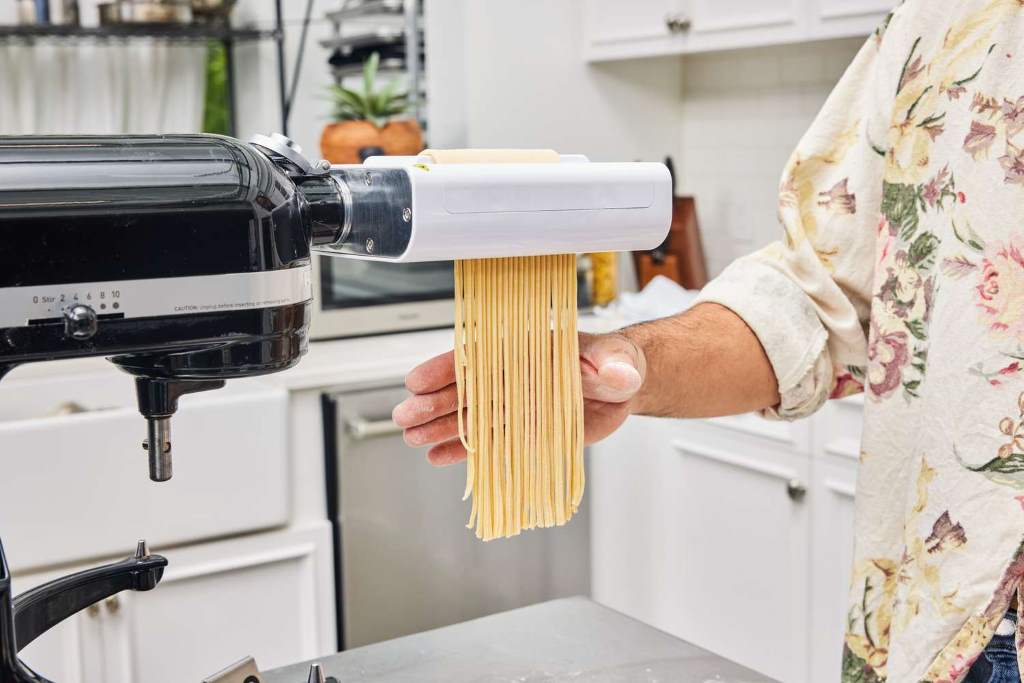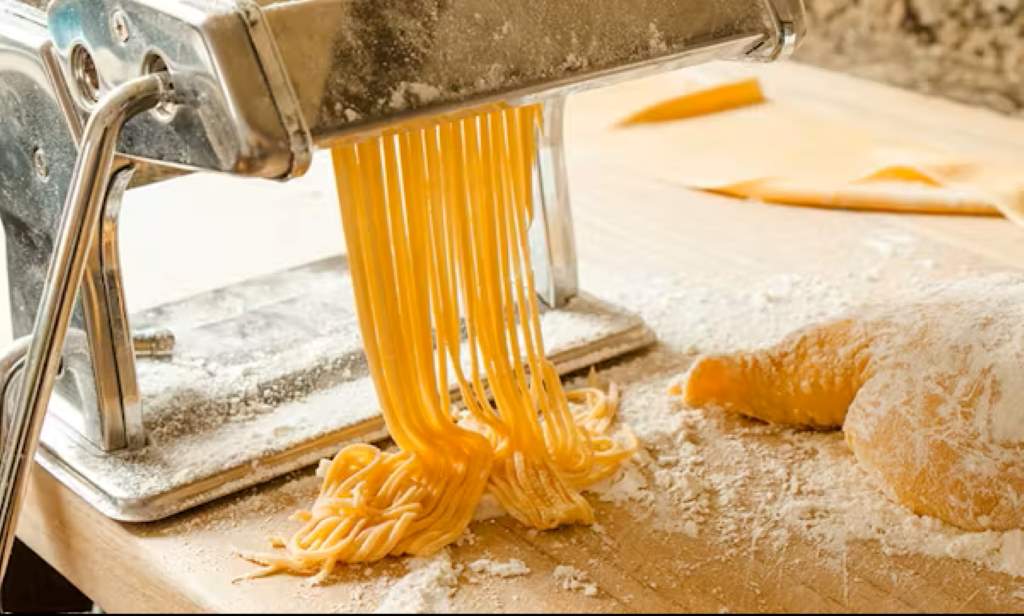Imagine the scent of garlic and basil filling your home as golden strands of fresh pasta twirl onto your plate. You crafted them yourself, without a single plastic wrapper in sight. That’s the joy of sustainable pasta making. In today’s world, kitchens buzz with gadgets that promise convenience, yet many pile up waste and guzzle energy. However, electric pasta makers flip the script. They let you produce homemade pasta on demand, slashing the need for pre-packaged options that clutter landfills.
According to Harvard’s Nutrition Source, up to 40% of food produced in the US goes uneaten, much of it from excess packaging in store-bought staples like pasta. Moreover, a 2024 study from Utah State University Extension reveals that average households waste 31.9% of acquired food, often tied to inefficient cooking tools. Enter eco-friendly kitchen gadgets like electric pasta makers—they empower you to cook fresh, reduce scraps, and embrace a greener routine. In this electric pasta maker review, we spotlight how these tools transform your space into a hub of sustainability and flavor.
The Rise of Sustainable Kitchens
Kitchens evolve fast these days. Families seek ways to blend daily meals with planet-friendly choices. Sustainable pasta making fits right in, drawing crowds who crave fresh tastes without the guilt. For instance, picture a busy parent rolling out dough after work, knowing each sheet cuts down on carbon-heavy imports. Trends show this shift clearly.
A 2024 report from Penn State Extension notes that home cooking surges amid health booms, with pasta leading as a versatile star. Additionally, global pasta consumption hits 50.9 billion dollars in 2023, projected to grow at 3.4% yearly through 2030, per GlobeNewswire data. Yet, not all methods serve the earth equally. Traditional boiling pots waste heat, while gadgets like electric pasta makers optimize every step.
Furthermore, eco-conscious cooks turn to tools that last. They ditch single-use plastics for durable steel frames that endure years of use. This approach not only saves money over time but also lightens your environmental load. Consider how one family in Seattle revamped their routine. They swapped boxed noodles for a home machine, trimming weekly waste by half. Such stories inspire, showing small swaps yield big wins. Therefore, as you explore these gadgets, think about your own habits. How might fresh pasta redefine your table?

Understanding Electric Pasta Makers
Electric pasta makers stand out in the crowd of kitchen helpers. They take the sweat out of dough work, letting you focus on creativity. At their core, these devices feature rollers that flatten dough precisely, plus cutters for shapes like spaghetti or ravioli. You feed in a simple mix of flour and eggs, and the motor hums to life, producing sheets ready for your touch. Unlike bulky stand mixers, they sit compact on counters, blending into daily life seamlessly.
Moreover, modern models boast adjustable settings. You dial in thickness from delicate lasagne layers to hearty fettuccine. This versatility suits beginners and pros alike. For example, a novice cook might start with basic spaghetti, building confidence with each batch. Over time, they experiment with fillings or gluten-free blends. Such flexibility keeps meals exciting, encouraging frequent use. As a result, you eat more whole foods, boosting nutrition without extra effort.
In addition, these makers promote mindful eating. They connect you to ingredients, turning cooking into a ritual. Research from a 2023 Taylor & Francis study highlights how homemade pasta enriches fiber and protein intake while keeping glycemic indexes low. Thus, they nourish body and soul. When choosing one, look for sturdy builds that withstand heavy dough. Chrome-plated steel resists rust, ensuring longevity. Finally, pair it with quality flour for best results—your kitchen will thank you.
Key Features for Eco-Conscious Cooks
Top electric pasta makers pack smart touches that align with green living. First, motors run quietly and efficiently, minimizing power draw during short sessions. You finish a batch in minutes, avoiding prolonged energy use. Second, attachments expand options without buying multiples, cutting down on clutter and production waste.
Take the Made in Italy complete set, for instance. It bundles rollers, cutters, and a base into one cohesive package, crafted with precision since 1930. This heritage ensures parts fit flawlessly, reducing the need for replacements. Additionally, the Pastadrive 110V motor attaches easily, powering through tough dough without strain. Users rave about its stability—no wobbling mid-roll. These elements make sustainability practical, not preachy.
Furthermore, safety features shine. Non-slip feet keep things steady, while cool-touch exteriors prevent burns. For families, this means kids can join safely under watch. Overall, these traits elevate your setup, blending form with function.
Environmental Benefits of Home Pasta Production
Home pasta making shines for its low-impact profile. You control every element, from flour source to portion size, dodging excess that ends up in bins. Store-bought packs often mean overbuying, leading to that 40% waste rate we mentioned earlier. However, crafting fresh lets you scale to needs, trimming scraps dramatically.
Moreover, energy math favors these gadgets. A 2025 ResearchGate analysis shows home pasta cooking saves 18% energy over standard electric stoves. Electric makers use bursts of power for rolling, then you boil briefly—far less than factory lines churning tons daily. Barilla’s 2023 Sustainability Report underscores pasta’s inherent greenness: low water needs and CO2 emissions in production. By making at home, you amplify that.
Additionally, carbon footprints shrink. Appliances account for 39% of energy-related CO2 globally, per CLASP’s Net Zero Heroes report. Yet efficient tools like these offset that by enabling precise cooking. One case study from a UK household cut emissions 3.9% via smart gadgets, as noted in a 2024 4D Products insight. Imagine applying that to pasta nights. You also support local flours, shortening supply chains. Therefore, each twirl of dough fights climate woes subtly but surely.
Step-by-Step Guide to Using Your Electric Pasta Maker
Ready to dive in? Follow this guide for flawless results every time. Start with quality basics to set a strong foundation.
- Prepare Your Dough: Mix 2 cups flour with 3 eggs in a bowl. Knead until smooth, about 10 minutes. Wrap and rest for 30 minutes. This step builds elasticity, ensuring even rolling later.
- Set Up the Machine: Clamp your electric pasta maker to the counter. Attach the Pastadrive 110V motor securely. Select the widest roller setting. Dust lightly with flour to prevent sticking.
- Roll the Dough: Cut dough into portions. Feed one through the rollers while the motor runs slowly. Fold and repeat, narrowing settings gradually. Aim for silky sheets—no tears mean better texture.
- Cut Your Shapes: Swap to cutters. Pass sheets through for spaghetti or fettuccine. Hang strands to dry slightly, avoiding clumps. Freshness peaks in 15 minutes.
- Cook Immediately: Boil in salted water for 2-4 minutes. Test a strand; al dente bites back gently. Drain and sauce right away for peak flavor.
Troubleshoot with ease. If dough sticks, add more flour sparingly. For thicker pasta, stop at setting 5. Practice builds speed, turning novices into experts overnight. Moreover, involve kids here—they learn while munching rewards.
Delicious Recipes to Get Started
Recipes breathe life into your maker. Try these sustainable twists, using seasonal veggies to keep things local and low-waste.
Lemon Herb Spaghetti
Bright and zesty, this dish uses garden scraps wisely. Roll thin strands, then toss with olive oil, lemon zest, and chopped herbs from your windowsill. Add cherry tomatoes for pops of color. Serves four in under 20 minutes post-dough. Guests always ask for seconds, praising the fresh snap.
Veggie-Packed Ravioli
Stuff pockets with spinach and ricotta from farmers’ markets. Your machine’s fine rollers create perfect seals. Steam lightly to retain nutrients. Pair with a simple tomato sauce from canned basics—no fresh buys needed. This meal stretches leftovers into luxury.
Gluten-Free Fettuccine Alfredo
Swap wheat for rice flour blends. The motor handles sticky mixes smoothly. Cream sauce from almond milk keeps it dairy-free and light. Sprinkle nutritional yeast for cheesy depth. Ideal for inclusive dinners, proving green cooking excludes no one.
Experiment freely. Swap proteins for beans to amp plant power. Each creation cuts reliance on processed foods, aligning with that 31.9% waste reduction goal. Share your tweaks online—communities thrive on such exchanges.
Comparing Electric to Traditional Methods
Electric makers edge out old-school cranks in green metrics. Manual tools demand elbow grease, often leading to uneven dough and discarded batches. Electric versions ensure consistency, minimizing errors. Energy-wise, they sip power briefly, unlike stoves simmering forgotten pots.
Furthermore, waste drops sharply. Traditional boiling overcooks easily, swelling scraps. Precise rolling means exact portions. A 2024 ScienceDirect study on kitchen energy notes electric aids cut usage by up to 31% versus gas setups. Durability counts too. Italian builds like the Made in Italy complete set outlast cheap plastics, sparing future buys.
However, manuals suit off-grid fans. They zero energy entirely. Yet for daily use, electrics win on efficiency. One user swapped after years; her output doubled without fatigue. Thus, weigh your style—both paths lead to sustainability.
Tips for Maximizing Sustainability in Pasta Making
Boost your impact with these habits. They turn good intentions into real change.
- Source Local Flours: Hunt mills nearby. Shorter trips mean fewer emissions. Organic options enrich soil health too.
- Compost Scraps: Dough trimmings feed gardens. Worms love them, closing the loop naturally.
- Batch Cook Smart: Make extra, freeze flat. Thaw as needed to avoid rushed buys.
- Pair with Efficient Boiling: Use lids, match pot sizes. This slashes water and heat loss.
- Clean Eco-Way: Wipe with cloths, skip harsh soaps. Bamboo brushes scrub gently.
Incorporate one tip weekly. Track progress in a journal—small victories motivate. Communities online share hacks, fostering collective growth.
Integrating Other Eco-Friendly Gadgets
Pasta makers pair beautifully with kin. Induction cooktops heat fast, wasting less gas. Energy Star fridges store dough balls efficiently, extending freshness. Bamboo utensils replace plastic, biodegrading harmlessly.
Moreover, solar chargers power small motors off-grid. A 2025 NKBA report spotlights these combos in sustainable designs, slashing footprints further. Start simple: add a compost bin nearby. Your kitchen becomes a symphony of green tools, each note harmonious.
Case in point: A Portland chef integrated three gadgets, halving her weekly energy bill. Stories like hers prove synergy works wonders.
Conclusion
Sustainable pasta making redefines home cooking through eco-friendly kitchen gadgets like electric pasta makers. You gain fresh flavors, cut waste by up to 40%, and trim energy with precise tools. From the Made in Italy complete set to the Pastadrive 110V’s smooth power, these devices blend tradition with innovation. Recipes inspire, tips empower, and comparisons clarify paths forward. Embrace this shift today. Grab your machine, roll that first sheet, and savor the difference. Your planet—and palate—will thank you. Start crafting now; share your first dish on social media with #GreenPastaPower.
Frequently Asked Questions
What Makes Electric Pasta Makers Eco-Friendly?
They reduce packaging waste from store-bought pasta and use energy efficiently for short tasks. Home production cuts transport emissions too. Studies show up to 18% less cooking power overall.
Can Beginners Use an Electric Pasta Maker?
Absolutely. Motors handle tough dough, while adjustable settings guide you. Start with basic recipes; confidence grows fast. Many models include recipe cards for ease.
How Does Home Pasta Making Reduce Food Waste?
You portion exactly, avoiding overbuying. Fresh batches encourage eating soon, unlike shelf-stable packs. Compost any bits, turning potential trash into soil gold.
Are There Gluten-Free Options for Electric Makers?
Yes. Use alternative flours like quinoa or chickpea. The machine rolls them smoothly, though hydration tweaks help. Results rival wheat for texture and taste.
How Often Should I Clean My Electric Pasta Maker?
After each use, wipe rollers with a damp cloth. Dry thoroughly to prevent rust. Deep clean monthly with a soft brush. This keeps it ready for action.
Ref:
- https://nutritionsource.hsph.harvard.edu/sustainability/food-waste/
- https://www.clasp.ngo/report/net-zero-heroes/appliances-impacts-and-benefits/
- https://www.researchgate.net/publication/312481058_Energy_efficiency_and_carbon_footprint_of_home_pasta_cooking_appliances
- https://extension.usu.edu/nutrition/research/reducing-food-waste-at-home




